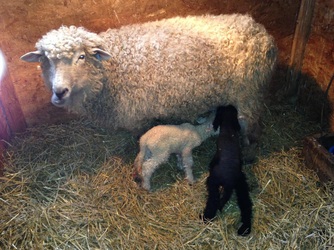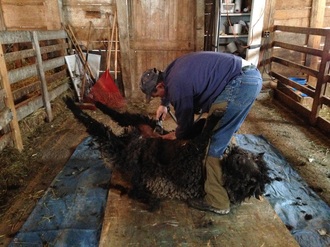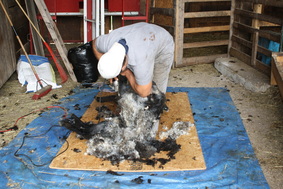|
A friend of mine recently once encouraged me to "try something that scares you every day". Well that something for me this past week was learning how to wash my own sheep fleece. Washing the wool is one of the first steps to processing it, and the main purpose is to get rid of the lanolin and organic matter. Lanolin is the oil naturally produced by sheep to keep the wool clean, act as a moisturizer and help shed water. Lanolin accounts for anywhere between 5-25% of the raw wool weight. I previously have had wool washed by several local businesses, and the price ranges from $4-8.00 per pound. We have been sending 50lbs or more at a time to have it processed into yarn, blankets and roving, so I thought I would investigate the process to see if it is worth doing myself. I have been nervous to try it for fear of felting (or otherwise ruining) the wool. Since I have been home on break from school with a barn full of freshly shorn fleeces, I figured I would give it a try. Below is the process I used, which I found on Spinderella's Wool Mill website. I have modified some of their instructions, which I will try to describe in my processes. If any of you are wool washing veterans and have suggestions for improvement, please let me know. 1. We sheared the middle of December (see previous post), and during shearing, we try to make sure we are separating out manure tags, belly wool, etc. in the barn to reduce the amount of skirting to be done in the house. Even still, I spent over 30min. on each fleece, picking through it, discarding organic matter and undesirable wool before starting the wash process. I usually did this the night before so I could get started with washing first thing in the morning. 2. The website calls for water up to 150 degrees. Our tap water didn't get that hot (until we turned up the thermostat), so for the first couple attempts, I was boiling water on the stove and dumping it in the machine... not exactly quick, but it worked. Once you fill a washing machine full of hot water, you dump in detergent (I used Dawn), stir in to not create suds, and add the fiber handful by handful. The fiber then sits in the hot water for 20 min. The article mentioned adding salt to the water, but our water is soft and our fleeces are not extremely dirty, so I did not bother with this. I also used less detergent (2/3 - 3/4 cup instead of 1 whole cup). 3. After the fleece sat for 20min. in the hot, soapy water, I lifted it out into the sink next to the washer. I then drained the dirty water and refilled with hot water and soap to repeat Step 1 for a total of 2 washes. The second wash I let sit for 15-18min. instead of 20min. I don't really think the time makes much of a difference. The first couple times I actually spun out the water as the article mentioned. Since then, I have not done this and lifted out the fleece to reduce the amount of agitation. I also ruined two fleeces by felting during this stage because I accidently left the washer on before the spin step. 4. Next, I conducted 3 rinses using the same method: Fill up the washer with warm water, add the fleece by the handful, and then lifted out after a few minutes. On the 3rd rinse, I actually let the washer spin out the water and the fleece to get a lot of the water out to assist with the drying process. The article mentions putting baking soda and vinegar in one of the last rinses, but I didn't find that necessary because the water was very clear by the 3rd rinse. 5. After spinning out, I laid a tarp out by our wood stove in the living room, and spread the fleece out. Throughout the day, I would fluff up the fleece, turn it over, and pick out large pieces of organic matter still left in the wool. It was actually amazing to see how much chaff still came out while it was drying! Our cat really loved laying in the wool! (as you can see by the photo above!). After ruining 2 fleeces, I was feeling a bit discouraged, but someone said I was paying too much attention to the little details of doing it right, and to not worry about the temperature of the water, measuring the detergent exactly, timing the soaks, etc. It took me 2-2.5 hours per fleece, as I was taking my time lifting out the wool and placing it back in the water each time. I have since washed 5 fleeces successfully and will continue to make this a winter project! Four of the fleeces will be going to Finger Lakes Woolen Mill to be made into roving, the fifth will probably get made into yarn. Only about 10 more to go... haha Again, any input to speed up the process or personal experience would be appreciated. :)
3 Comments
 Emmy with her two new lambs, born Saturday. Emmy with her two new lambs, born Saturday. Surprises happen all the time on the farm. Those of you involved in agriculture are well aware... We start breeding our ewes right after the county fair in July, hoping that all lambs will be born before the middle of February. A sheep's gestation period is approximately 148 days, which is why were very surprised to find these two cute lambs in the barn Saturday morning! Counting backwards, this ewe must have been bred the first day they were in with the ram, and run a few days short on her gestation period. This is one of our Hampshire-Lincoln crosses, so its always a surprise to see what colors the lambs end up being. The black one is a ewe lamb and the white one is a ram lamb. They are 7/8ths Lincoln. We had to bring the ewe lamb inside for a few hours due to the temperatures being in the teen's and her brother being a more aggressive nurser. But after sitting by the fire in our living room for a few hours, she's been much more active. Because we are a small hobby farm with only a few lambs at a time, often end up with a few in the house during the winter "just in case". Hopefully this means more lambs will be coming very soon!  Benny, our yearling ram, being shorn. Benny, our yearling ram, being shorn. So after a surprise on Saturday morning, we got to surprise the sheep by shearing. People often ask why we decide to shear at the beginning of winter. It is a bit odd, but we do it for several reasons: 1. We shear in May for the summer and for our shows in the fall, and by the time winter comes around, they have a very long fleece on them. They stay in the barn for most of the winter, so we want to make sure we shear them for a high quality fleece before it gets matted and dirty during the winter in the barn. 2. Our first sheep show is always the first weekend in May, and we like to have a minimum of 12 weeks of wool on the sheep, which means we have to shear in December. 3. Because our sheep have so much wool, lambs sometimes have a hard time finding the udder underneath the mother when they are born. Additionally, we keep a close eye on our ewes when we are expecting lambs, and you can often tell when a ewe is going into labor by a swollen vulva and mucus. These signs are difficult to see with so much wool. On ewes with full fleece, people often "crotch" the ewes, which is shearing just their rump and under the belly, to assist the lamb. We just prefer to shear them. While each sheep is being shorn, someone is nearby skirting the previous sheep's fleece. Skirting is the process of picking through the wool to get out any organic matter, straw, matted clumps, and short or low quality pieces (like stomach or leg wool). We now have about 30 fleeces to do something with! In the coming weeks, we will be packaging all the newly shorn wool to be sent to MacAusland's Woolen Mill and the Finger Lakes Woolen Mill to be made into blankets, yarn and roving. We also will be saving some of the nicer fleeces to be sold as raw fleeces to handspinners. Send us an email if you are interested! Our semi-annual shearing day is rapidly approaching, and after very successful sales at the NYS Sheep and Wool Festival, we are very interested in having more products made out of our wool. The question is... what will you all buy? If you could take just a second to fill out this quick survey, it will really help us determine what products to spend most of our resources marketing. Thanks! :)  This past Saturday we sheared all the sheep for spring. Several were sheared at the Maryland Sheep and Wool Festival as part of the shearing demonstration by Emily Chamelin (she is so cool! World-known shearer who competes internationally in sheep shearing... yes that is a real thing! http://chamelinshearing.com/), but the rest at home needed to be done before summer. Because we consider ourselves a "show flock", we shear twice a year, based on our show schedule. We aim to have a minimum of 12 weeks of wool growth for each show. This is obviously not possible for every show, so our shearing schedule is based around our biggest shows: Maryland in May, and the Big E and New York State Sheep and Wool Festival in September and October. This means that we shear right before Christmas in December, and then again in May. Every time we shear, there's usually an audience. This time is was my uncle and aunt from Kansas who were visiting for the weekend. My friend who does it for us is pretty used to that by now. Each sheep takes about 5-10 minutes depending on their size and how "squirmy" they are. We then quickly "skirt" the fleece, meaning we go through it to pick out any organic material and unwanted wool. We generally pick out the leg wool and the belly wool, as they do not have as high quality as the rest of the wool. Whatever we don't want gets thrown out, and the good part gets bagged and weighed for selling. Because we just sheared, we have plenty of raw fleeces for sale ranging from lighter charcoal in color to dark black, both lamb and adult fleeces. Contact us if interested. Fleeces are $10.00/lb. |
AuthorEmmaline Long, main owner of Orchard View Farm, has a passion for Lincoln sheep and loves educating others about her breed and farm, She currently serves as the Vice President of the National Lincoln Breeders Association. Archives
October 2020
Categories
All
|
Orchard View Lincoln Longwools7617 S. Lake Rd., Bergen NY 14416 |
Contact UsStay Up-To-DateFollow our blog!
|







